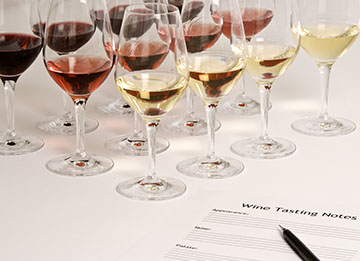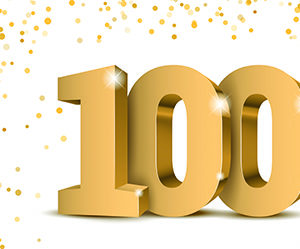
Why do we subject our wines to competitions? Is it for the professional feedback? Is it for the tasting notes? Is it for the bragging rights? Regardless of your reason to enter your wine into a wine competition, interpreting the feedback can sometimes be a little tricky.
I entered my very first wine in the WineMaker International Amateur Wine Competition in 2013. It was my first red blend. I called it “Too Petite.” It was a blend of Petite Sirah and Petit Verdot. I hand harvested the Petit Verdot with my friends Adrienne Power (a physical therapist from San Francisco who I bribed with free wine at the end of the deal) and Todd Lanza (whose father was part owner in the vineyard and who felt bad for me and Adrienne). We started harvesting at 6 a.m. and it took us around four and a half hours. Thankfully I didn’t have to hand harvest Petite Sirah. I was able to crush right out of the crates the grapes are shipped in.
With the help of Todd, Adrienne, and my winemaking mentor at the time, Rick Lanza, I created my very first red wine blend.
I was so proud. So proud in fact that I entered it in the WineMaker competition. And you know what I got? A bronze. In my mind this wine was liquid gold. The hard work that went into picking that Petit Verdot, the long hours crushing, pressing, babysitting, and bottling that wine were rushing through my mind. What happened? Why did my wine medal as a bronze?!
As a wine judge and home winemaker I take my judging feedback very seriously. The feedback I received on my Too Petite consisted of the comments “high acid,” “astringent,” “good aromas,” “lay down,” and “needs age.” Upset and frustrated I asked a friend who was a wine judge and she explained this was because my wine was young and most likely in bottle shock when I sent it in. Wow! Why didn’t I think of that? She was absolutely right. My wine was still developing, and although good, did not hit that perfect balance point in order to earn a gold medal.
Unfortunately between myself, friends, and family we drank all of the Too Petite before I could enter it in the next year’s competition. But that’s neither here nor there. Although, it would have been great to see what the next year’s set of judges would have said (and have been able to keep tasting this wine as it matured).
Sometimes when we enter our wines we are so excited and proud we forget that the wines are being judged. We forget that they are going to be tasted by a professional, whose job is to give constructive feedback for your current vintage and future vintages. It can be sobering reading the judging feedback at times, and it can be amazing when you win that gold or best of show. What helps a lot is being able to interpret what the wine judge is trying to communicate to you.
Reading Your Judging Notes
Don’t just read through the judging feedback when you receive it. Take time to carefully consider each of the comments. I suggest two steps when going through each set of judging notes:
Pour yourself a glass of wine (ideally, a glass of the wine for which you are reading the score sheets of so you can ponder the feedback as you sip the wine).
Have your winemaking notes out. These will help in understanding why the judges gave you the feedback that they did.
Judging Sheet Breakdown
The ways points are awarded to a wine may vary slightly from competition to competition, however the following: Appearance (3 points), Aroma and Bouquet (6 points), Taste (6 points), Aftertaste (3 points), and Overall Impression (2 points) are the categories used in the WineMaker competition. Let’s take a closer look at these categories.
Appearance
Appearance is based on the wine’s intensity of color, if the color is characteristic of the varietal, its clarity, and the viscosity of the wine.
Your wine’s color may be described as pale, medium, or deep. This indicates the hue and intensity of your wine. If the wine color represents the varietal characteristic then you will gain points. However, if your wine is labeled as a rosé and it is deep ruby in color you will lose points.
When it comes to color, white wines can be straw, yellow, gold, etc., and reds can range from purple, to ruby, and garnet. Generally, any of these colors is acceptable, but scores may be docked if browning appears. If your wine is clear or “clean” looking, you can see through the glass and there are no obstructions, you will gain points. If your wine has any “floaties” or deposits in the liquid so to speak then you will be docked points. A wine will be docked points if it is cloudy and not clear. Points will be gained if the wine has any legs/viscosity.
Aroma and Bouquet
This is one of the most important components of your wine. It’s been said that 80% of your information comes from smelling your wine. The nose/bouquet of your wine is its calling card. This section gets the ball rolling on whether your wine will medal.
There are many layers of wine aromas. The first thing a judge will ask him or herself is, “is this wine faulted?” The next step is identifying if the aromas jump out of the glass. Is there a light, medium, or pronounced amount of aromas coming out of the bouquet? The next layer consists of the characteristics of the aromas. Do these aromas represent the wine varietal? Are they pleasant? Are they offensive?
When judging wine you are not only searching for faults, but for pleasant aromas as well. The judges are smelling for primary aromas (influenced by the grape variety), secondary aromas (influenced by fermentation), and tertiary aromas (influenced by aging or oxidation). You may see on your tasting notes “forest floor” — this is not a negative comment, but a positive comment. This means your wine is giving off positive earthy aromas.
Taste
Wine is consumed for its flavor, not for its nutritional content. The flavor on the taster’s palate is almost as important as the wine’s bouquet.
The judges will taste your wine and ask themselves the following questions. What is the sweetness level of the wine? Is the acid of the wine in balance and characteristic of the wine variety? What is the tannin level intensity? Is the alcohol in balance? Are the wine flavors displayed and varietally/stylistically characteristic? What are the flavor characteristics? These questions are not to dissect your wine, but to help decipher if the wine is in balance. If a wine is balanced, it is generally considered good and well made. This means a medal is coming your way!
Getting to that next level of medal can be tricky. The judges are also looking for those primary, secondary, and tertiary aromas on the palate. They may be different than what came through in the bouquet, but there should be some extra flavors that pop out after taking a sip.
Aftertaste
The aftertaste has the same weight as the appearance of the wine. However, this leaves a lasting impression on the judge. Did the finish of the wine linger? Did the wine fall flat? Was the finish tart? Was it bitter? Was it smooth? Was it creamy? This is the last tasting component that the judge will experience. It will also likely still be on their mind when they get to the final judging criteria.
Overall Impression
Finally, the judges will look back at their notes and think about the overall feeling of the wine. Would they consider it: Objectionable? Needing improvement? Of good quality, or of excellent quality? Do they consider the wine too young? Drinkable now? Suitable for aging? Here you will find the culmination of how your wine measured up.
Most Common Wine Judging Notes and What They Mean
Med, Med (-), Med (+)
You might see “Med (‘+/-’)” on your judging sheet. This comes from the WSET’s Systematic Approach to Tasting Wine. The +/- helps indicate the level of acid, tannin, or intensity the judge is feeling in the wine. For example a wine might make your mouth water, indicating a medium amount of acid, but if it has a quick sharp component to it, then that is usually described as Medium (+) acidity. If there is a perception of acid, but it is fleeting, the judge might describe it as Medium (-). Please note that neither Medium (-) or Medium (+) is a negative comment about your wine. It is only pointing out the components of intensity in the wine.
You will see “Med,” “Med (-),” “Med (+),” and “Pronounced” on your judging sheet possibly regarding sweetness, acidity, tannin, alcohol, body, and finish.
Astringent
When you see the word “astringent,” this could mean that the tannins in your wine are off balance. Astringent tannins create an unpleasant feeling in your mouth. The tannins are overly aggressive and can give an overly dry sensation to your mouth.
Astringent can also mean that the wine is a little “pithy” or too acidic. Have you ever tasted a grapefruit pith (the white tissue lining the rind)? It’s sour but tannic and gives your mouth that overwhelming and unpleasant feeling. That is usually the sensation wine judges are describing when they put down astringent.
This might even indicate that the wine is too young. Think about it. A big, bold red wine needs some time in the bottle. I got the word “astringent” in my tasting notes and it hurt. But really, what it came down to is the wine needed some aging and/or decanting, and that’s OK.
Muted
When you see the word “muted” it means that there is aroma or flavor, but the judge feels there should be more of that present in the wine. Usually, muted aromas are caused by too hot of fermentation temperatures. This is where you bring out your winemaking notes and see if your red wine fermentation got above 80 °F (27 °C). If the red wine fermentation went above this temperature, this could be the culprit. White wines should be fermented even cooler to protect and preserve fruit aromas.
Muted flavors on the palate usually indicate lax racking practices, too hot of a ferment, or over oaking. What you have to remember is in order to be considered a pleasant wine the wine has to be balanced. So even if the flavors are pleasant, if you have to fight to find them as a taster, your wine will be docked points.
Not varietally characteristic
This means the wine can still be balanced but it is not giving off the flavor of the wine it was submitted as. For example, if you enter your Chardonnay that is a super sweet wine in the Chardonnay category, then you will most likely get points docked. This is because normally a Chardonnay is made in the dry style. If you entered that Chardonnay in a sweet wine category you might have gotten a higher score, because in that category it’s not about the wine type but about the level of sweetness in the wine.
Structure
This is referring to the balance of sweetness, acidity, tannin, alcohol, and body of the wine. If all of these components are in balance then you will get a high score; if one or more of these components stand out, then the balance is off.
Judging Panels
Three judges are usually assigned to a panel to taste each wine in order to gain a representative view of the wine.
Everyone’s taste buds, nasal biology, and tasting experiences are different. When judging wines, having three judges helps ensure that the judges are thoroughly and non-biasedly judging your wines.
How to decipher conflicting comments
Sometimes you get wine judges who just can’t seem to agree. They know what they tasted and they do not taste the same things as their fellow judges. Here is where we, as entrants, need to take a step back and remember that there are three different types of wine tasters. There are non-sensitive tasters, who have fewer than 15 taste buds at the tips of their tongues. There are average tasters who have 15–30 taste buds, and hypersensitive tasters who have 30+ taste buds at the tips of their tongues. Neither taster is necessarily better than the other. However, depending on the type of taster you are relates to your perception of bitterness. This is why having three judges can help offset any biased perceptions due to their taste buds. This understanding is also important to consider when you do not taste the same things as the judges did when commenting on your wine.
So if their comments don’t match each other, this is what you do. Read them over. Do any of them resonate with you? Can you see where one of the judges is coming from? Ask a friend to taste your wine and see which judge he or she resonates with the most. Re-taste your wine and see if anything jumps out at you. If you find something that you resonate with, focus on that judge’s comments. This is because this judge tastes similarly to you, so you most likely enjoy the same types of wine. At this point the other judging notes should be considered a different view into your wine. Not negative, but different. Maybe they have some constructive feedback that can help further your winemaking. Don’t rule them out just because they don’t agree.
What if there is no comment written?
This happens sometimes. However, if the comment section is blank, celebrate because that means everything was in balance for that section. Woot woot! Go you!
Common Wine Faults Found during Judging
It is important to point out some of the more common wine faults judges find in wines. I won’t go into great detail here, because Christiana McDougal wrote a fantastic article outlining wine faults in the June-July 2019 issue. But it is good to keep these in mind when reading
your feedback.
Oxidation
Oxidation generally occurs when wine is exposed to too much oxygen post-fermentation. It leads to browning in color and diminished aroma and flavor. Off-aromas of stewed fruits, walnuts, and hay are common.
Reduction
Opposite of oxidation, wines that are reduced have too little air exposure and the result is usually skunky, sulfurous smells that remind you of eggs or burnt matches.
Volatile Acidity
Caused by various spoilage yeasts and bacteria, volatile acidity (VA) is often detected as an aroma and flavor of vinegar or nail polish remover.
Brettanomyces
Brettanomyces (Brett) is a wild yeast that produces volatile phenols. It results in reduced varietal character as well as aromas of barnyard, cheese, or Band-Aid.
Other common issues seen at wine competitions
• Wines being over-oaked. (I know what you’re thinking, “but those judges just don’t like oak.” Nope, that’s not it. The problem is that the judges can’t taste anything besides oak. For a wine to be considered as “balanced” there needs to be that balance between fruit and oak. When it is difficult to smell or taste the fruit, the wine is over-oaked.)
• Not varietally characteristic.
• Muted aromas and flavors.
• Too young, needs aging
• Before you send in your bottle
Taste your wine and give it a self-evaluation. Make sure your wine isn’t faulted. Even if it is and you want to send it in for feedback anyway, you will be prepared to read your feedback.
Give as much information as possible on the entry sheet. Especially when it comes to blends. Judges want to know which varieties they are tasting.
Make sure your wine is in the correct category. Especially when it comes to sweetness. This is a big reason people do not medal. It is the responsibility of the entrant to make sure their wine is assigned to the correct category, and the responsibility of the judges to judge it based on the category it is assigned to.
Run the numbers on your wine. Is your wine officially through malolactic fermentation? Is there a slight effervescence on the palate? Make sure your wine is stable and ready to be tasted.
Use this experience to grow
Entering your wine into a wine competition is a lot of fun. You learn descriptors you never thought could be used to describe wine. Flint? Who knew that was a thing? You learn new tips and techniques to further your winemaking in the years to come. And you gain confidence and bragging rights.
Home winemaking is a labor of love. It’s about why you make it, who you are making it with, and who you are making it for. As a wine judge, if I taste a wine that is a touch astringent all I can think about is the great time those winemakers were having. They had such a good time talking, drinking, and reminiscing that they may have pressed those grapes a bit too hard. The wine may not be perfect, but the experience of making your own wine is why we, as home winemakers, are in the hobby. But that doesn’t mean you can’t learn from those mistakes.
Amateur wine competitions exist to help you bring your wine to the next level, but also to celebrate this tasty drink that you created. Wine is about the story and the passion of the winemaker behind it. Regardless of what your feedback says know this: Your wine is awesome because you created it with your bare hands. And that in itself deserves a medal.







